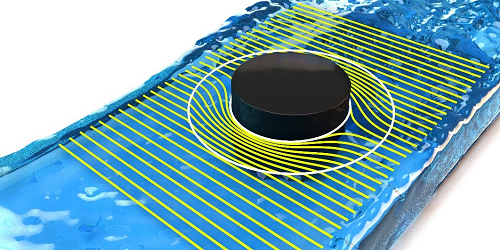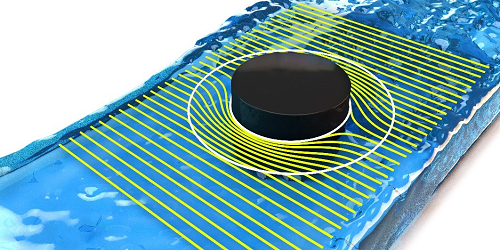Hydrodynamic Cloaks
What do you get when you cross Harry Potter with Aquaman? An invisibility cloak that works in water, of course. Physicists have taken steps towards this sci-fi mashup with two structural systems that direct fluid flow around an object. The first cloak is a ring of small pillars that deflects incoming fluid in such a way that there is zero drag in the middle of the ring. The second cloak is a pair of thin platforms that funnels waves around objects inside a water channel.
Electromagnetic cloaks—which appeared more than a decade ago—rely on complex structures called metamaterials that bend light waves in ways that traditional materials cannot. Metamaterials can also be designed to work with other wave phenomena, such as sound and heat. As far as fluids are concerned, previous attempts at a hydrodynamical cloak have required active elements, such as micropumps (see 11 August 2011 Synopsis).
Juhyuk Park from Seoul National University in South Korea and colleagues have devised a passive cloak that doesn’t require any input energy. The team first calculated the type of metamaterial needed to cancel the drag on a small obstacle sitting in a sheet of slow-moving fluid. The resulting design is a circular “maze” consisting of 523 pillars that direct flow away from the central region—where the obstacle is located. In experiments, the researchers placed a cylinder inside the cloak and observed how flowing water detoured around the object without generating any downstream wake. With further improvement, such a device could reduce the drag on ships or submarines.
For their passive hydrodynamic cloak, a team of researchers from Zhejiang University and Xiamen University in China had a different aim: reduce the amplitude of water waves inside a channel. The team took inspiration from waveguide cloaks, which use gradient index metamaterials (GIMs) to convert light waves into narrow “trapped modes” that can avoid obstacles in optical waveguides. The researchers installed two thin platforms along the sidewalls of a 60-m-long wave tank. The platforms acted like GIMs by creating shallow regions where waves travel more slowly. In tests with a broad range of wave frequencies, the team found that incoming plane waves converted to trapped modes above the platforms, leaving the middle of the tank nearly wave-free. The team imagines installing such a system in a port or wharf to protect ships.
This research is published in Physical Review Letters.
–Michael Schirber
Michael Schirber is a Corresponding Editor for Physics based in Lyon, France.





